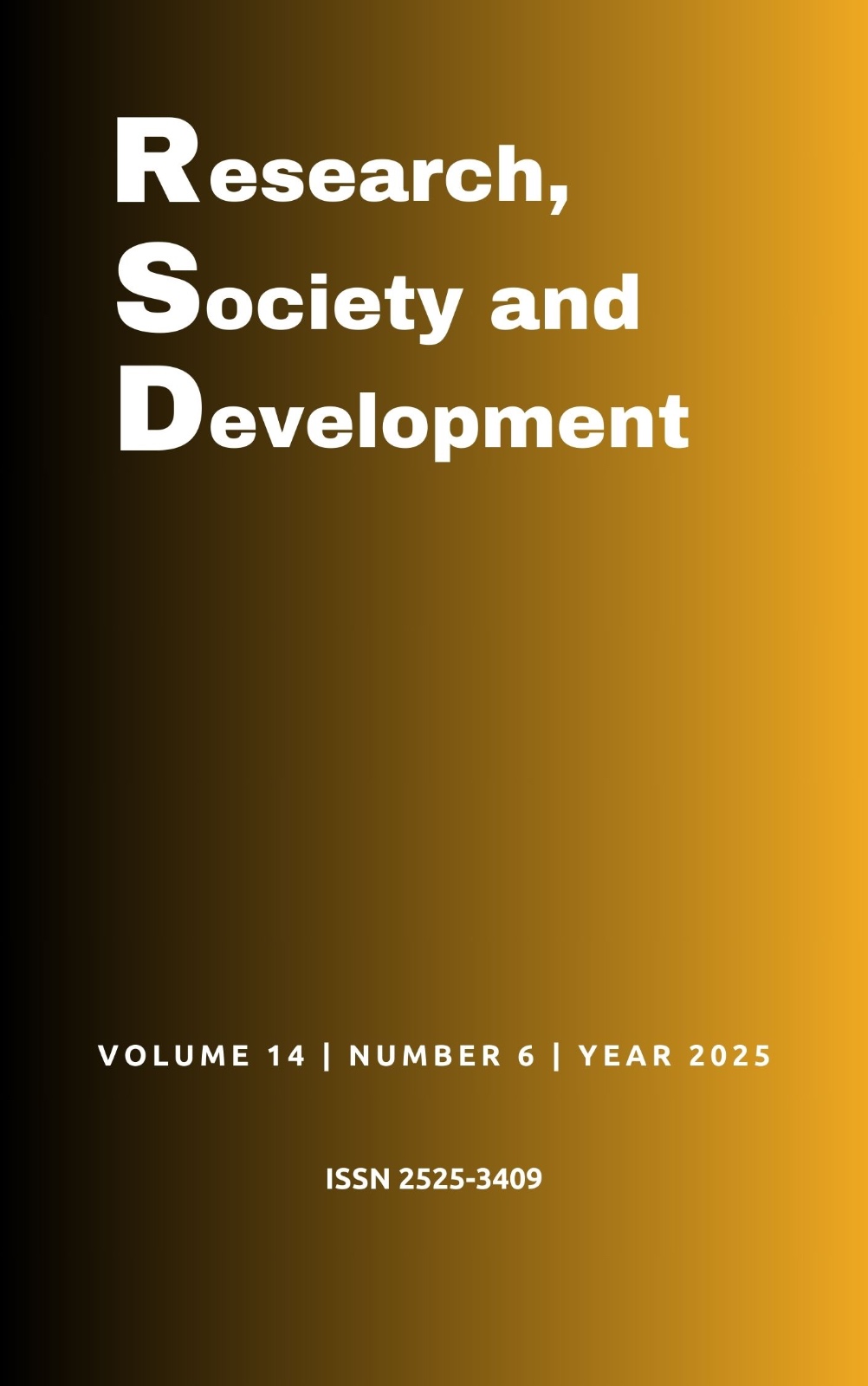Post-COVID 19 narcolepsy, a case report
DOI:
https://doi.org/10.33448/rsd-v14i6.48848Keywords:
Narcolepsy, COVID-19, Infection, Insomnia, REM sleep.Abstract
Objective: The aim of this article was to report the case of a teenager who developed narcolepsy after infection with COVID-19 and there were no other infections that could justify the case. Methodology: information was obtained through medical record review, recording of diagnostic methods and literature review. Case report: Patient B.M.C, female, 16 years old, presented to the clinic due to episodes of narcolepsy. Final considerations: the reported case and publications raised shed light on the possibility that COVID-19 infection also causes narcolepsy, which is a new means of triggering this pathology.
Downloads
References
Alóe, F., Alves, R. C., Araújo, J. F., Azevedo, A., Bacelar, A., Bezerra, M., Bittencourt, L. R. A., Bustamante, G., Cardoso, T. A. M. de O., Eckeli, A. L., Fernandes, R. M. F., Goulart, L., Pradella-Hallinan, M., Hasan, R., Sander, H. H., Pinto Jr., L. R., Lopes, M. C., Minhoto, G. R., Moraes, W., & Moreira, G. A. (2010). Diretrizes brasileiras para o diagnóstico de narcolepsia. Brazilian Journal of Psychiatry. 32(3), 294–305.
Bayon V, Damien Léger D, Philip P. (2009). Socio-professional handicap and accidental risk in patients with hypersomnias of central origin. Sleep Med. 13(6), 421-6.
Brundin, L., Björkqvist, M., Petersén, Å. & Träskman-Bendz, L. (2007). Reduced orexin levels in the cerebrospinal fluid of suicidal patients with major depressive disorder. European Neuropsychopharmacology. 17(9), 573–9.
Chemelli, R. M., Willie, J. T., Sinton, C. M., Elmquist, J. K., Scammell, T., Lee, C., Richardson, J. A., Williams, S. Clay., Xiong, Y., Kisanuki, Y., Fitch, T. E., Nakazato, M., Hammer, R. E., Saper, C. B., & Yanagisawa, M. (1999). Narcolepsy in orexin Knockout Mice. Cell. 98 (4), 437–51.
Complex HLA-DR and -DQ Interactions Confer Risk of Narcolepsy-Cataplexy in Three Ethnic Groups. (2001). The American Journal of Human Genetics. 68(3), 686–99.
Dauvilliers, Y. & Arnulf, I. (2008). Narcolepsie avec cataplexie. Revue Neurologique. 164(8-9), 634-45.
de Almeida Andrade, P. H., Rodrigues Morais de Oliveira, M., Diniz Morais, S. M., Aguiar Gripp Junior, F. & Gonçalves Nobre, A. F. (2024). Doenças Autoimunes: Atualização no Diagnóstico e Tratamento em Clínica Geral. Brazilian Journal of Implantology and Health Sciences. 6(10), 1999–2009.
Franceschini, C., Pizza, F., Cavalli, F. & Plazzi, G. (2021). A practical guide to the pharmacological and behavioral therapy of Narcolepsy. Neurotherapeutics. 18(1), 6-19. doi: 10.1007/s13311-021-01051-4.
Frauscher, B., Ehrmann, L., Mitterling, T., Gabelia, D., Gschliesser, V., Brandauer, E., Poewe, W., & Högl, B. (2013). Delayed Diagnosis, Range of Severity, and Multiple Sleep Comorbidities: A Clinical and Polysomnographic Analysis of 100 Patients of the Innsbruck Narcolepsy Cohort. Journal of Clinical Sleep Medicine.
Goldman, L., & Schafer, A. I. (2019). Goldman-Cecil medicine. Elsevier, Inc. 6598-6600.
Heydendael, W., Sengupta, A., Beck, S. & Bhatnagar, S. (2014). Optogenetic examination identifies a context-specific role for orexins/hypocretins in anxiety-related behavior. Physiology & Behavior. 130, 182–90.
Huang, Y.-S., Guilleminault, C., Lin, C.-H., Chen, C.-H., Chin, W.-C. & Chen, T.-S. (2018). Multiple sleep latency test in narcolepsy type 1 and narcolepsy type 2: A 5-year follow-up study. Journal of Sleep Research. 27(5), e12700.
Ito, E. & Inoue, Y. (2015). [The International Classification of Sleep Disorders, third edition. American Academy of Sleep Medicine. Includes bibliographies and index. Nihon Rinsho. Japanese Journal of Clinical Medicine. 73(6), 916–23.
Jameson, J. (2019). Harrison’s manual of medicine. (20th ed.). McGraw-Hill, Ed. 740-5.
Kawai, M., O’Hara, R., Einen, M., Lin, L. & Mignot, E. (2015). Narcolepsy in African Americans. Sleep. 38(11), 1673–81.
Kornum, B. R. & Jennum, P. (2020). The case for narcolepsy as an autoimmune disease. Expert Review of Clinical Immunology, 16(3). https://doi.org/10.1080/1744666X.2020.1719832.
Medeiros, M. R. B. & Silva, R. C. L. M. & Almondes, K. M., K. (2022). Narcolepsia na Infância: A Atuação Multidisciplinar com a Psicologia do Sono do Diagnóstico ao Tratamento em um Relato de Caso. Psicologia: Ciência E Profissão, 42.
https://doi.org/10.1590/1982-3703003243224. https://www.scielo.br/j/pcp/a/yzpGRdW63cMNt78CFKW7cMm/abstract/?lang=pt.
Morgadinho, F., Coelho, S., Motta Elias, R., Pradella-Hallinan, M., Rita, L., Bittencourt, A. & Tufik, S. (2007). Revisão da Literatura Narcolepsia Narcolepsy. Arch. Clin. Psychiatry (São Paulo) 34(3). https://doi.org/10.1590/S0101-60832007000300005.
Morgenthaler T I, Kapur V K, Brown T, Swick T J, Alessi C, Aurora R N, Boehlecke B, Chesson A L Jr, Friedman L, Maganti R, Owens J, Pancer J, Zak R. (s.d.). Standards of Practice Committee of the American Academy of Sleep Medicine. Practice parameters for the treatment of narcolepsy and other hypersomnias of central origin. Sleep, 30(12), 1705-11.
Pereira A. S. et al. (2018). Metodologia da pesquisa científica. [free e-book]. Editora UAB/NTE/UFSM.
Quaedackers, L., Pillen, S. & Overeem, S. (2021). Recognizing the Symptom Spectrum of Narcolepsy to Improve Timely Diagnosis: A Narrative Review. Nature and Science of Sleep. 13, 1083–96.
Roya, Y., Farzaneh, B., Mostafa, A-D., Mahsa, S. & Babak, Z. (2023). Narcolepsy following COVID‐19: A case report and review of potential mechanisms. Clinical Case Reports. 1 (6), e7370. doi: 10.1002/ccr3.7370. https://pmc.ncbi.nlm.nih.gov/articles/PMC10213711/
Downloads
Published
Issue
Section
License
Copyright (c) 2025 Rodrigo Henrique Nogueira Mamédio; Rafael Vinhal da Costa

This work is licensed under a Creative Commons Attribution 4.0 International License.
Authors who publish with this journal agree to the following terms:
1) Authors retain copyright and grant the journal right of first publication with the work simultaneously licensed under a Creative Commons Attribution License that allows others to share the work with an acknowledgement of the work's authorship and initial publication in this journal.
2) Authors are able to enter into separate, additional contractual arrangements for the non-exclusive distribution of the journal's published version of the work (e.g., post it to an institutional repository or publish it in a book), with an acknowledgement of its initial publication in this journal.
3) Authors are permitted and encouraged to post their work online (e.g., in institutional repositories or on their website) prior to and during the submission process, as it can lead to productive exchanges, as well as earlier and greater citation of published work.


